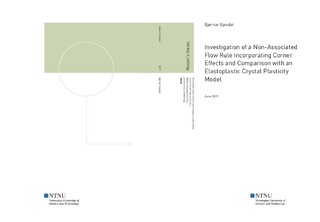| dc.contributor.advisor | Holmedal, Bjørn | |
| dc.contributor.author | Gjesdal, Bjørnar | |
| dc.date.accessioned | 2019-10-19T14:02:33Z | |
| dc.date.available | 2019-10-19T14:02:33Z | |
| dc.date.issued | 2019 | |
| dc.identifier.uri | http://hdl.handle.net/11250/2623368 | |
| dc.description.abstract | Den konvensjonelle assosierte flyteregelen, brukt i kontinuums plastisitetsmodeller, er uegnet til prediksjon av flytinstabiliteter i tynne plater under biaksiell last og plastisk bukling ved bifurkasjonsanalyse. Teorien tilsier at introduksjon av et hjørne på materialets instantane flyteflate tilfører en destabiliserende effekt, som er nødvendig for at en modell skal predikere instabiliteter, med bifurkasjonsanalyse ved realistiske tøyninger. Flere flyteregler har blitt intodusert, som tar hensyn til hjørneeffekter, hvor det siste bidraget er foreslått av Yoshida i 2018. Den konstitutive modellen foreslått av Yoshida har blitt implementert for videre undersøkelser. Parallelt har en elastoplastisk rate-uavhengig krystallplastitisitetsmodell blitt implementert. Denne inkluderer også hjørneeffekten, og er derfor egnet til sammenlikning. De to modellene har blitt sammenliknet ved å utføre virtuelle tøyningsvei-endrings eksperimenter. Her har spenningsveien, retningen til den plastiske deformasjonsraten, vinkelen mellom den plastiske deformasjonraten og den totale deformasjonsraten og vinkelen mellom den plastiske deformasjonsraten og flyteflatenormalen blitt undersøkt. Resultatene indikerer at begge modeller kvalitativt introduserer en hjørneeffekt, men at det kvantitativt kan være utfordrende å finne modellparametere som gir overenstemmelse for alle typer eksperiment. For å måle den kvantitative avstanden mellom modellene har det blitt brukt en gjennomsnittlig vinkel mellom deviatoriske spenningspunkt. En optimeringsalgoritme har blitt implementert for å minimere dette målet, med gode resultater. Resultatene tyder likevel på at det trolig ikke er mulig å finne et sett med modellparameter som matcher alle eksperimenter, ettersom det ser ut til at sammenhengen for den krystallplastiske modellene er mer kompleks. Det er imidlertid ingen tvil om at den foreslåtte modellen kvalitativt implementerer hjørneeffekten. | |
| dc.description.abstract | The conventional associated flow rule, used in continuum plasticity models, is unsuited for precise prediction of necking in biaxially loaded sheets and plastic buckling, through bifurcation analysis. It is believed that the introduction of a corner on the subsequent yield surface of the material introduces the necessary destabilizing effect for a model to predict instabilities at realistic limit strains. Several flow rules incorporating a corner effect have been introduced, with the latest being the one of Yoshida. The proposed non-associated flow rule has been implemented in order to test the proposed constitutive model. In parallel, the rate-independent elastoplastic Taylor-Lin crystal plasticity model has been implemented, which does also incorporate the corner effects. The two models have been compared by performing virtual strain path change experiments and comparing stress paths and the direction of the plastic deformation rate both with respect to the yield surface and the directions of the total deformation rate and the yield surface normal. The results indicate that the model qualitatively incorporates the corner effect, however, they also imply that calibration of the model to fit all types of experiments in a quantitative manner is not possible. To measure the difference between the two models an average angle between deviatoric stress points, has been used as the quantitative measure. An attempt has been made to find the optimal model parameters for the presented model, by minimizing the mentioned quantity. The overall conclusion is that the model incorporates the corner effect, however, the model might be unsuited if the speed at which it slides along the surface, is of great importance. It should be noted that the Taylor-Lin model is also an approximation, and how close its behavior is to reality, must be verified experimentally or by more advanced models, like CPFEM. | |
| dc.language | eng | |
| dc.publisher | NTNU | |
| dc.title | Investigation of a Non-Associated Flow Rule Incorporating Corner Effects and Comparison with an Elastoplastic Crystal Plasticity Model | |
| dc.type | Master thesis | |
